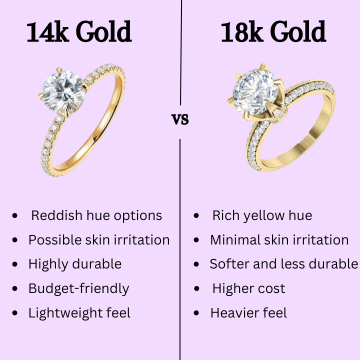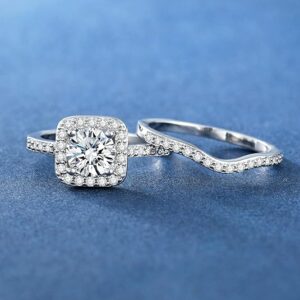Ever stood in a jewelry store or scrolled through an online catalog, staring at two nearly identical gold pieces—one marked 14K and the other 18K—and thought, “What’s the difference, really?”
You’re not alone. This is one of the most common (and confusing) decisions jewelry buyers face.
And if you’re shopping for something important—like an engagement ring, anniversary gift, or even just treating yourself—it’s a decision that really matters.
Don’t worry—we’ll break all this down step by step in this post so it’s easy to understand, even if you’ve never bought gold jewelry before. Ready? Let’s dive into the world of karats and gold!
Table of Contents
What Does ‘Karat’ Mean in Gold?
Karat (K) is used to measure the purity of gold. Gold is a soft metal, so it’s usually mixed with other metals (like copper, silver, or nickel) to make it strong enough for daily wear. Like 24K gold is 100% pure gold — but it’s also very soft and scratches easily. That’s why jewelers create 14K, 18K, 10K, etc. — each one mixes gold with other metals for added strength. So, the higher the karat, the more pure gold is in the jewelry—and typically, the softer and more expensive it is. Choosing the right karat comes down to balancing appearance, durability, price, and skin sensitivity.
| Feature | 14K Gold | 18K Gold |
|---|---|---|
| Gold Content | Made of 58.3% real gold and 41.7% other metals. | Made of 75% real gold and 25% other metals. |
| Color | Has a lighter, softer yellow color. Looks simple and modern. | Has a deeper, richer yellow color. Looks more traditional and fancy. |
| Durability | Stronger and harder. Less likely to scratch. Good for daily use. | Softer and easier to scratch. Better for special occasions. |
| Price | More affordable. Great if you want good quality at a lower price. | More expensive. You're paying for higher gold content and shine. |
| Skin Sensitivity | Might bother people with sensitive skin, especially if it has nickel. | Gentle on skin. A better choice if you have allergies or metal reactions. |
| Best For | Everyday jewelry like rings, bracelets, or pieces you wear all the time. | Fancy or meaningful jewelry, like gifts or items for special events. |
Composition
- 14K gold contains 58.3% pure gold, with the remaining 41.7% made up of alloy metals like copper, silver, zinc, or nickel. These alloys make it stronger and more affordable but slightly less pure.
- 18K gold is 75% pure gold and 25% alloy metals. This higher purity means you’re getting more real gold, which gives it a richer appearance but also makes it softer and more expensive.
Color
- 14k Gold due to its higher percentage of alloy metals tends to have a more muted appearance. In yellow gold, the tone is softer and less rich—perfect for a modern or everyday look. 14K white gold often appears brighter and whiter, thanks to rhodium plating, while 14K rose gold has a bolder pink tone due to more copper in the mix. The added alloys not only affect color but also enhance durability.
- 18k Gold with more pure gold in the mix, shows richer, warmer tones across all color variations. Yellow gold in 18K is noticeably deeper and more luxurious in appearance. White gold has a slightly warmer undertone than 14K but still maintains a refined, elegant finish when rhodium plated. 18k Rose gold has a softer, subtler pink that gives it a romantic, vintage-inspired charm.
Durability
- 14K gold is stronger and more scratch-resistant because of its higher alloy content. That makes it perfect for daily wear, especially rings or bracelets that take a lot of impact.
- 18K gold is softer and more prone to scratching and bending. While it’s still durable, it’s best worn in settings where it won’t be exposed to rough surfaces or daily wear and tear.
Price
- 14K gold is more budget-friendly, thanks to its lower gold content. It’s an excellent choice if you’re shopping for quality jewelry without spending a fortune.
- 18K gold comes with a higher price tag, but you’re paying for more pure gold, better skin compatibility, and a premium, luxurious appearance.
Skin Sensitivity
- 14K gold might irritate sensitive skin, especially if nickel is used in the alloy mix. People with metal allergies might experience redness or itchiness after prolonged wear.
- 18K gold is gentler on the skin due to its higher gold purity. It’s often considered hypoallergenic, especially if alloyed with skin-safe metals like silver or palladium.
Best For
- 14K gold is ideal for everyday jewelry—wedding bands, engagement rings, bracelets—especially if you’re active and want something durable.
- 18K gold is great for fine jewelry, formal wear, or gifts. It’s also perfect for people who want a bold gold look or have sensitive skin.

14K Gold Advantages and Disadvantages
Advantages:
14K gold is an excellent option for those on a budget, offering a more affordable price point than 18K gold. It’s also incredibly durable and scratch-resistant due to its higher alloy content, making it ideal for everyday wear, especially for active individuals. The muted yellow tone of 14K gold gives it a modern, understated look that works well with both casual and formal styles.
Disadvantages:
However, 14K gold contains only 58.3% pure gold, which means it doesn’t have the rich, deep color that 18K gold offers. Additionally, the alloy mix used in 14K gold can sometimes cause skin irritation, particularly for those with metal sensitivities. While it’s a great practical option, 14K gold lacks the luxurious feel of higher-karat gold, which may not meet the expectations of those looking for high-end, premium jewelry.
18K Gold Advantages and Disadvantages
Advantages:
On the other hand, 18K gold is made up of 75% pure gold, giving it a richer, more vibrant yellow hue that many associate with luxury. It’s gentler on the skin and is often hypoallergenic, making it a great choice for those with sensitive skin or allergies to certain alloys. 18K gold is also perfect for special occasions and fine jewelry, adding an elegant touch to pieces like engagement rings, necklaces, or heirloom items.
Disadvantages:
The main downside of 18K gold is its higher price due to the increased gold content. It’s also softer than 14K gold, which makes it more prone to scratches, dents, and bending, so extra care is required, especially if you plan to wear it every day. Additionally, the softness of 18K gold may lead to a higher maintenance requirement to keep it looking pristine over time.
Frequently Asked Question's
It depends on what you’re looking for. 14K gold is better for everyday wear because it’s more durable and affordable. But if you want a more luxurious look, 18K gold is better due to its higher purity and richer yellow tone. So “better” really means what fits your lifestyle and budget best.
14K gold lasts longer in terms of resisting scratches and everyday wear and tear. Because it contains more alloy metals, it’s tougher and less likely to bend or get damaged. 18K gold is softer and may need more care over time.
Yes, 14K gold is perfect for daily wear. It’s strong, durable, and can handle everyday tasks like handwashing, cooking, or working out. That’s why it’s a popular choice for engagement rings and wedding bands.
14K gold is 100% real gold. It just means the jewelry is made of 58.3% pure gold and 41.7% alloy metals. These alloys give it strength and help it stand up to everyday use. It’s not fake—it’s practical!
It depends on your needs. If you want a ring that lasts and can handle daily wear, go for 14K. If you prefer a richer color and more gold purity, and you don’t mind being a little more careful, 18K is a beautiful, luxurious choice.
Absolutely! 14K gold is one of the best values in the gold jewelry world. You get a good amount of gold content, excellent durability, and a lower price than 18K. It’s a smart buy if you want quality without overspending.
Yes, 14K gold is water-resistant, but not completely waterproof. It won’t rust or tarnish easily if you get it wet occasionally. However, repeated exposure to water (especially saltwater or chlorine) can dull its shine over time—so it’s best to remove your jewelry before swimming or showering.
18K gold doesn’t fade in color because the gold itself is very stable. However, because it’s softer, it may get scratched or lose its polish faster than 14K gold. A simple professional polish can bring it back to life if that happens.
18K gold is slightly heavier than 14K gold because it has more pure gold content. The difference isn’t huge, but you might notice a more solid, luxurious feel with 18K pieces—especially in bigger items like bangles or thick chains.



